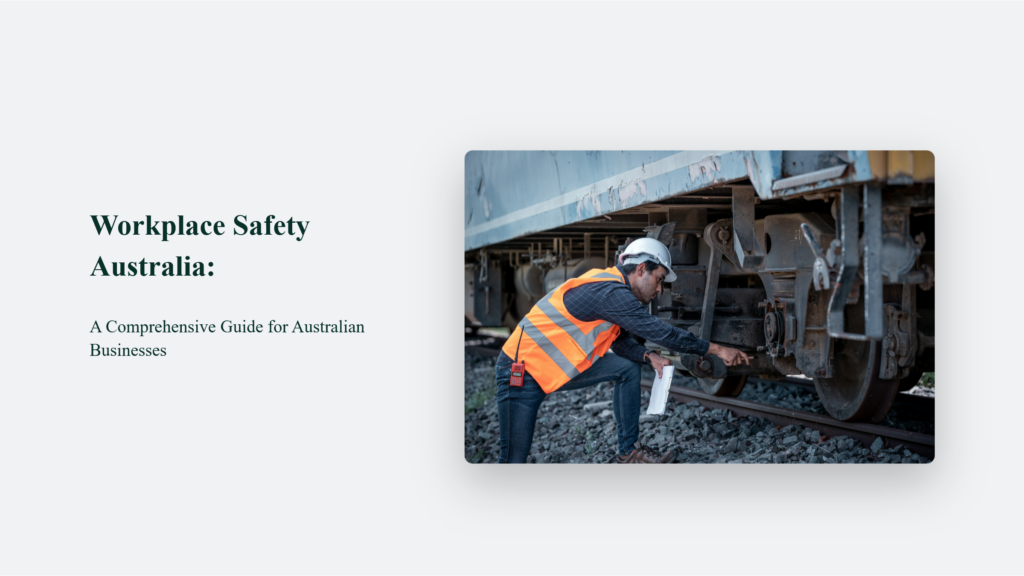

Workplace Safety Australia: A Comprehensive Guide for Australian Businesses

As Seen On
Workplace safety Australia is not just a legal obligation but a moral imperative. Every year, countless workers suffer injuries, illnesses, or even fatalities due to inadequate safety measures. As an employer or business owner, you must create a safe and healthy work environment for your employees. This article will delve into the importance of workplace health and safety Australia, the legal requirements, and practical strategies to foster a robust safety culture within your organisation.

The Significance of Workplace Safety
Workplace safety is a cornerstone of any successful business operation. Beyond the ethical considerations, prioritising safety can have far-reaching benefits for your organisation:
- Reduced Costs: Workplace accidents and injuries can result in costly workers’ compensation claims, legal fees, and lost productivity. You can minimise these financial burdens and protect your bottom line by implementing effective safety measures.
- Improved Employee Morale and Retention: Employees who feel valued and protected are more likely to be engaged, productive, and loyal to your company. A safe work environment fosters a positive company culture and attracts top talent.
- Enhanced Reputation: In today’s socially conscious climate, businesses with a strong commitment to workplace safety are viewed favourably by customers, investors, and the community. A solid safety record can give you a competitive edge.
- Legal Compliance: Failure to adhere to workplace safety regulations can result in hefty fines, legal penalties, and potential shutdowns. Maintaining compliance is a legal obligation and a safeguard against costly consequences.
Understanding the Legal Framework of Workplace Safety Australia:
Australia has a robust legal framework governing workplace safety, with the primary legislation being the Work Health and Safety Act 2011 (WHS Act). This act outlines the duties and obligations of employers, workers, and other parties involved in workplace occupational health.
Under the WHS Act, employers have a primary duty of care to ensure the health and safety of their workers and anyone else affected by their work activities. This duty encompasses providing a safe work environment, implementing safe work systems, offering adequate training and supervision, and supplying all persons with appropriate personal protective equipment (PPE).
Moreover, the act mandates that employers consult with workers and their representatives on matters related to worker health and safety and ensure that workers are fully aware of their rights and responsibilities regarding workplace safety.
The WHS Act establishes a comprehensive legal framework that strongly emphasises employers’ responsibility to prioritise the well-being, work, health, and safety of their workforce and others impacted by their operations. Compliance with this act is a legal obligation and a crucial step towards creating a safe and secure work environment for all.
Implementing a Comprehensive Safety Program
Developing and implementing a comprehensive safety program tailored to your organisation’s needs is essential to effectively manage workplace safety. Here are some key components to consider:
- Risk Assessment and Management: Conduct regular risk assessments to identify potential hazards in your workplace. Once identified, implement appropriate control measures to eliminate or minimise these risks.
- Safety Policies and Procedures: Develop clear and concise safety policies and procedures that outline the expectations, responsibilities, and protocols for various work tasks and situations. Ensure that these policies are regularly reviewed and updated to reflect changes in workplace or industry standards.
- Training and Education: Provide comprehensive safety training to all employees, including new hires, contractors, and temporary workers. Ensure that training is ongoing and covers topics such as hazard identification, safe work practices, emergency procedures, and the proper use of PPE.
- Incident Reporting and Investigation: Establish a robust system for reporting and investigating workplace incidents, near misses, and hazardous situations. Encourage employees to report any concerns without fear of retaliation and promptly address and resolve identified issues.
- Safety Inspections and Audits: Conduct regular safety inspections and audits to identify potential hazards, assess the effectiveness of existing control measures, and ensure compliance with relevant regulations and industry standards.
- Employee Involvement and Consultation: Encourage employee participation in developing and implementing safety programs. Establish safety committees or designate safety representatives to facilitate communication and collaboration between management and workers.
- Emergency Preparedness: Develop and regularly review emergency response plans to ensure your organisation is prepared to handle various emergencies, such as fires, chemical spills, or natural disasters.
Fostering a Positive Safety Culture
While implementing safety programs and policies is crucial, creating a positive safety culture within your organisation is equally important. A strong safety culture is one where safety is ingrained in every employee’s daily operations and mindset, from top management and professional development, to frontline workers.
To foster a positive safety culture, consider the following strategies:
- Leadership Commitment: Senior management must lead by example and commit to workplace safety. It includes allocating adequate resources, participating in safety initiatives, and holding themselves and others accountable for safety performance.
- Open Communication: Encourage open and transparent communication about safety concerns, near misses, and incidents. Create an environment where employees feel comfortable reporting issues without fear of retaliation.
- Recognition and Rewards: Recognise and reward employees who demonstrate exemplary safety practices, report hazards, or contribute to improving safety within the organisation.
- Continuous Improvement: Evaluate and improve your safety programs and practices based on feedback, incident investigations, and industry best practices. Embrace a mindset of continuous learning and improvement.
- Safety Ambassadors: Identify and empower safety ambassadors or champions within your organisation. These individuals can be role models, promote safety awareness, and facilitate communication between management and workers.
Conclusion
Workplace safety is not just a legal requirement but a fundamental responsibility for every Australian business. By prioritising safety, you protect your employees and safeguard your organisation’s financial well-being, reputation, and long-term success.
Remember, creating a safe work environment is an ongoing process that requires commitment, collaboration, and continuous improvement. Embrace a proactive approach to safety, foster and support a positive safety culture, and actively empower your employees to maintain a safe and healthy workplace.
By following the guidelines outlined in this article, you can ensure that your organisation remains compliant with Australian workplace safety laws while cultivating a culture that values the well-being mental health of your most valuable asset – your employees.
Gracie Jones
Up until working with Casey, we had only had poor to mediocre experiences outsourcing work to agencies. Casey & the team at CJ&CO are the exception to the rule.
Communication was beyond great, his understanding of our vision was phenomenal, and instead of needing babysitting like the other agencies we worked with, he was not only completely dependable but also gave us sound suggestions on how to get better results, at the risk of us not needing him for the initial job we requested (absolute gem).
This has truly been the first time we worked with someone outside of our business that quickly grasped our vision, and that I could completely forget about and would still deliver above expectations.
I honestly can’t wait to work in many more projects together!
Disclaimer
*The information this blog provides is for general informational purposes only and is not intended as financial or professional advice. The information may not reflect current developments and may be changed or updated without notice. Any opinions expressed on this blog are the author’s own and do not necessarily reflect the views of the author’s employer or any other organization. You should not act or rely on any information contained in this blog without first seeking the advice of a professional. No representation or warranty, express or implied, is made as to the accuracy or completeness of the information contained in this blog. The author and affiliated parties assume no liability for any errors or omissions.

